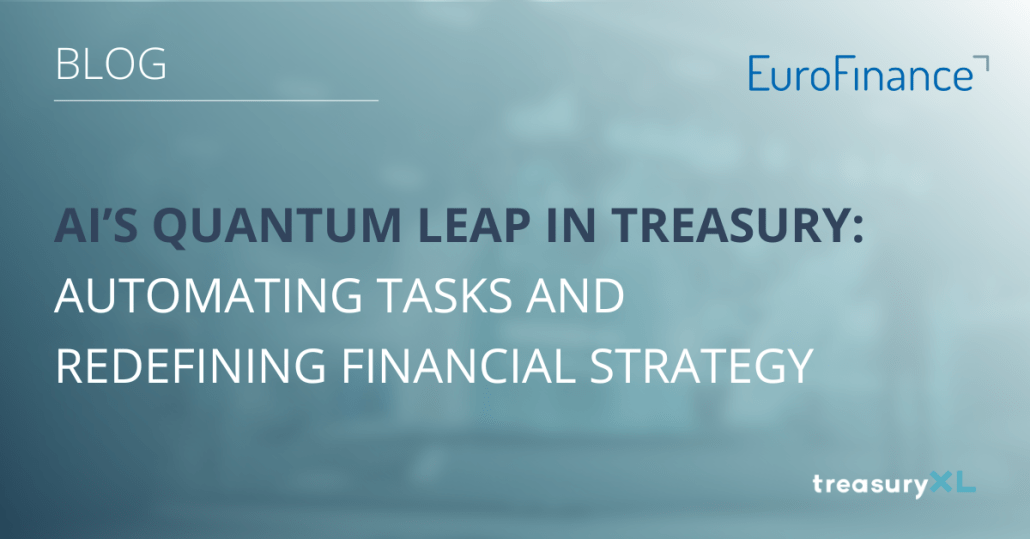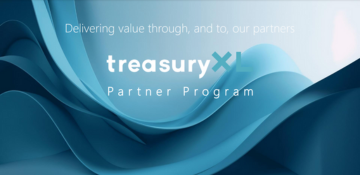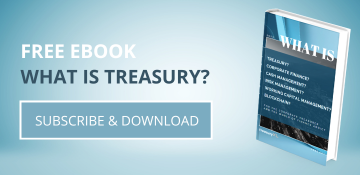Artificial intelligence (AI) is transforming industries across the globe, and treasury, is no exception
AI’s promise of automating repetitive tasks and improving decision-making at an unprecedented speed is reshaping the traditional treasury landscape. As Nvidia’s CEO Jensen Huang remarked at the Nvidia AI Summit 2024, “AI has no possibility of doing what humans can do. Depending on the jobs we do, it could do 20% of our jobs 1000 times better. For some people, it could do 50% of their job 1000 times better. But in no job can AI do all of it.”
In this light, Huang stressed the importance of using AI as an “assistant” in our daily tasks. “The real threat wouldn’t be AI taking over jobs—it’s more likely that the person who uses AI to automate that 20% is going to take your job,” Huang said.
At the 2024 EuroFinance International Treasury Managementevent, industry leaders including Lee-Ann Perkins, assistant treasurer at Ankura; Daria Severina, director of treasury at ASML Netherlands B.V., and Royston Da Costa, assistant treasurer at Ferguson, discussed the transformative potential of AI in treasury. They highlighted how AI can automate processes, enhance accuracy, and offer vital support during turbulent financial times, underscoring its crucial role in helping companies navigate and avoid financial challenges.
AI in treasury: the first steps
Perkins recalled a pivotal moment in her career when AI played a crucial role during Covid-19 pandemic, the oil price crash in March 2020. Her previous company, an oil and gas firm, faced enormous pressure to make quick and accurate financial decisions. “It was disastrous in many ways, and a lot of people had to work from their homes without the usual collaboration or resources they were accustomed to.” The challenge was further exacerbated when oil price futures went negative, putting the company in a highly leveraged position.
Fortunately, Perkins and her team had implemented a breakthrough AI forecasting system two years earlier. This system used multiple AI algorithms to scrub and structure data from disparate ERP systems, forecast information, detect anomalies, and conduct solvency and sensitivity analyses. As Perkins put it, this AI solution “saved the company, and not only did it save the company, but it saved jobs.”
This use of AI in forecasting allowed the company to provide real-time information to its CEO and shareholders, enabling dynamic decision-making at a time when the oil industry was in chaos. This experience solidified Perkins’ belief in AI’s potential: “I realised at that turning point that AI is going to be huge. It’s going to be in everything we do in the future.”
Perkins’ experience is not unique. Many treasury teams have begun to implement AI solutions to streamline processes and improve efficiency. Severina detailed how her team uses AI in various treasury functions, from hedging to cash flow forecasting. Severina’s team chose to entrust an AI model with part of the foreign exchange (FX) hedging decision-making, leading to a notable improvement in forecasting accuracy. Despite this, the team continues to oversee and validate all critical decisions, ensuring human oversight throughout.
As Severina explained, ASML, a leading supplier to the semiconductor industry. The company provides chipmakers with hardware, software and services to mass produce the patterns of integrated circuits (microchips), needed to hedge its currency exposure effectively. Initially, they used manual processes to forecast cash flows, achieving around 70% accuracy. However, when they shifted to an AI-powered model based on Python, their accuracy soared to 96-97%. Severina noted, “The model performed much better on its own when it only had the actuals,” highlighting AI’s ability to outperform human input when provided with reliable data.
The success of AI in treasury management at ASML demonstrates how AI can revolutionise traditional forecasting models, improving not only accuracy but also the speed and scalability of decision-making processes.
Automating the treasury workflow
Another area where AI has made a significant impact is in automation, particularly by simplifying and speeding up repetitive tasks. Da Costa, assistant treasurer at Ferguson, an American multinational distributor of plumbing and heating products, discussed how his team has embraced AI to automate various processes within treasury. For example, Ferguson uses a generative AI chatbot, to streamline payment processes, automating approvals that were previously done manually.
“We’re looking at the low-hanging fruit, meaning automation. This has allowed us to automate certain steps in our payment process. Instead of emailing approvers to approve a payment, they are notified automatically in each step of the process. There is also the possibility for setting up an app with the assistance of Co-Pilot which allows users to use the app and the information is then recorded in a system like Sharepoint,” Da Costa added.
Da Costa noted that such automation solutions are easy to implement, making them ideal for treasury teams looking to adopt AI without overhauling their entire system. He added that AI’s ability to automate back-office functions, such as settlement and confirmation processes, frees up valuable time for treasury professionals to focus on more strategic tasks.
AI as a collaborative tool, not a threat
While AI’s potential to automate tasks is immense, it is not about replacing treasury professionals. Severina urged treasury professionals not to be intimidated by AI. Instead, she recommended starting small by using tools like Python to experiment with AI models. “Start somewhere,” she said. “For treasurers, my personal advice would be to start with Python. Maybe you have an analyst in your team who is very computer savvy. Send them on a Python course and let them play around with the models—it will bring you a long way.”
Da Costa also shared insights on how AI can play a critical role in enhancing risk management. By analysing historical data and market trends, AI systems can provide treasurers with powerful tools for forecasting and liquidity management. “AI can sift through vast amounts of data in seconds, identifying patterns and predicting future trends that might not be immediately apparent,” he said, highlighting AI’s potential to improve decision-making processes.
Confidentiality and ethical considerations
However, as with any powerful technology, the implementation of AI comes with challenges, particularly around confidentiality and ethical use. Severina highlighted the need for companies to develop in-house AI solutions, such as the Python-based model her team uses, to ensure that proprietary data stays within the company’s firewall. This approach allows treasury departments to harness the power of AI while maintaining strict control over sensitive financial information.
Da Costa cautioned against relying solely on AI for high-risk decisions. “While AI can handle the mechanics, humans should remain the final decision-makers,” he asserted, advocating for a balanced approach that combines automation with human expertise, especially in critical areas like foreign exchange (FX) hedging.
The road ahead: AI’s role in treasury
AI is no longer a futuristic concept, it is already transforming how treasury departments operate, from improving forecasting accuracy to automating routine tasks. As Perkins, Severina, and Da Costa have demonstrated, AI has the potential to save companies from financial turmoil, enhance efficiency, and empower treasury professionals to make better decisions in real time.
But as AI becomes more integrated into treasury workflows, professionals must be mindful of the ethical and confidentiality concerns that accompany it. By starting small, experimenting with AI tools, and keeping security top of mind, treasury teams can harness AI’s full potential while navigating its challenges.
In the words of Da Costa, “The train has left the station… Are we either going to get on that train or are we going to be left behind?” For treasury professionals, the choice is clear: embrace AI or risk being left behind in a rapidly evolving financial landscape.














